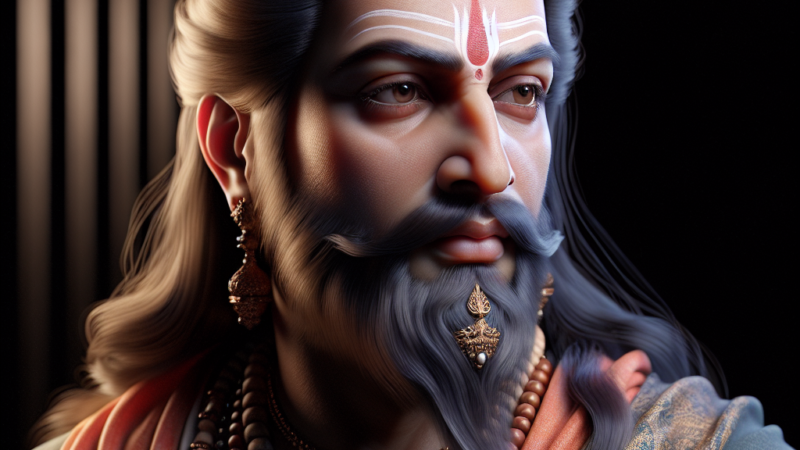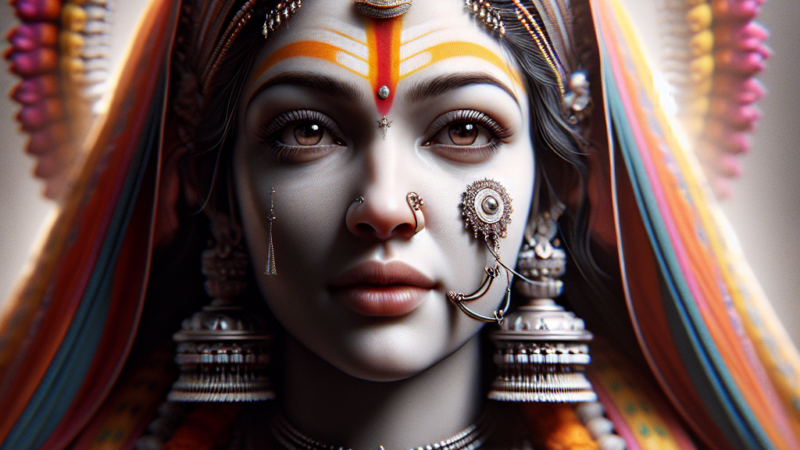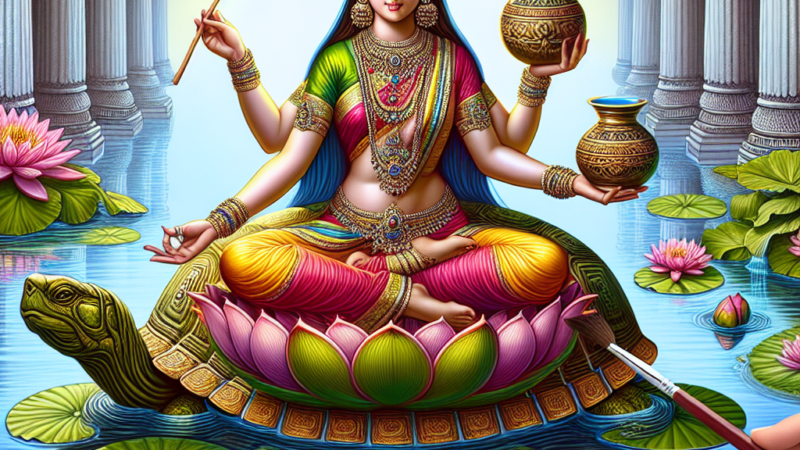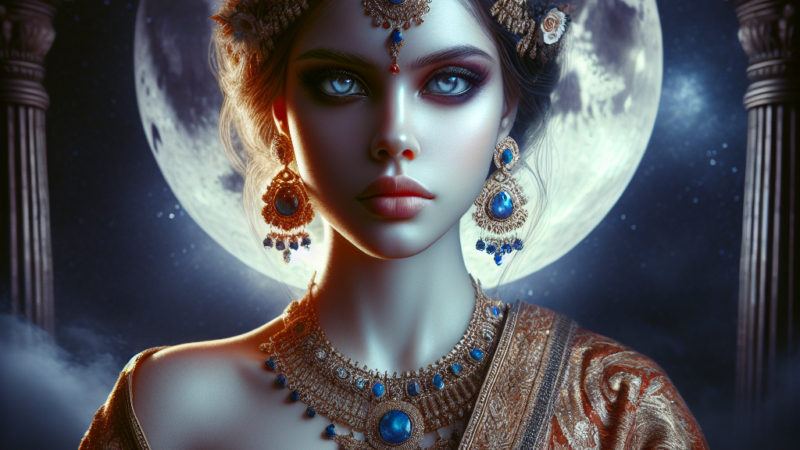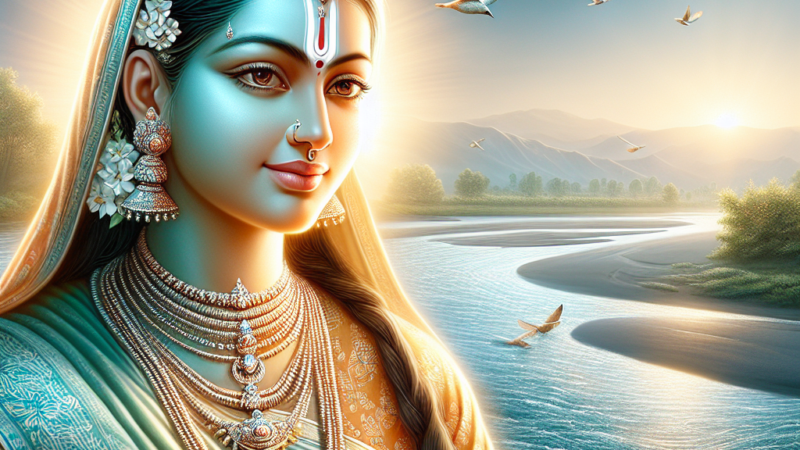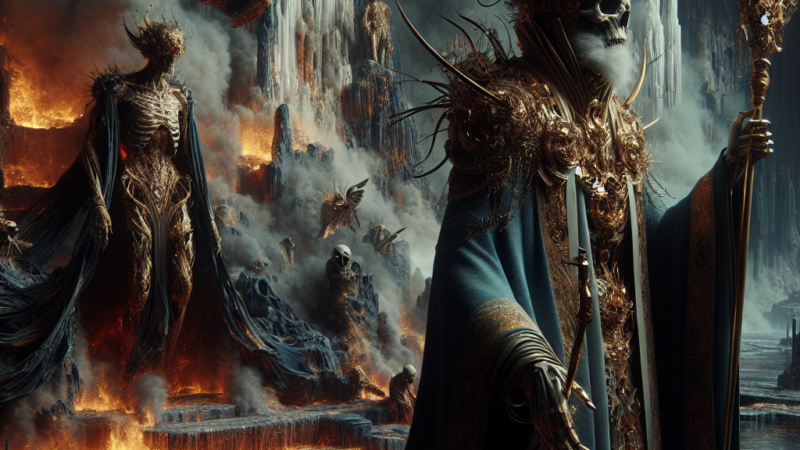Rudra: The Fierce and Destructive Form of Shiva
Introduction
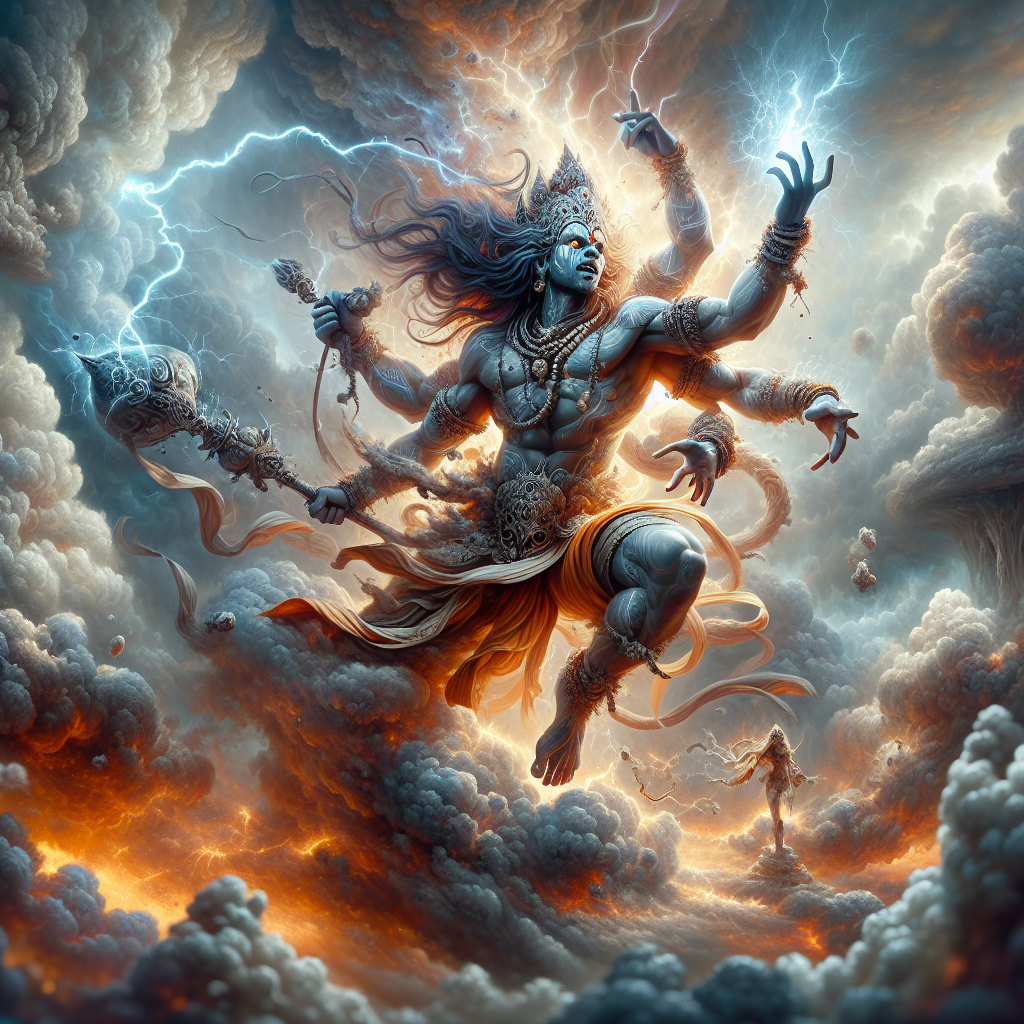
Rudra, a fierce and destructive form of the Hindu deity Shiva, holds a significant place in Hinduism. Known for his tempestuous nature and association with storms and destruction, Rudra is a complex figure embodying both the destructive and regenerative aspects of the universe. As an early form of Shiva, Rudra’s attributes and stories have evolved over time, reflecting the dynamic nature of Hindu mythology and religious practice.
In Hinduism, Rudra is revered as a powerful deity who can bring about both destruction and healing. His role is multifaceted, encompassing the fierce aspects of nature and the cosmos, as well as the potential for renewal and transformation. This duality makes Rudra a compelling figure in Hindu worship and mythology.
Etymology and Meaning
Origin of the Name Rudra
The name “Rudra” is derived from the Sanskrit root “rud,” which means “to cry” or “to howl.” This etymology reflects Rudra’s association with storms, wind, and the wild, untamed aspects of nature. The name also conveys a sense of fear and awe, fitting for a deity known for his fierce and destructive powers.
Variations of the Name Across Different Texts or Regions
Rudra is known by various names and epithets in different texts and regions. In the Vedas, he is often referred to as “Shiva,” meaning “the auspicious one,” highlighting his dual nature. Other names include “Bhava,” “Sharva,” and “Mahadeva,” each emphasizing different aspects of his character and attributes.
Symbolic Meaning of the Name
The name “Rudra” symbolizes the destructive and transformative power of the deity. It represents the idea that destruction is a necessary precursor to creation and renewal. This concept is central to Hindu cosmology, where the cycle of creation, preservation, and destruction is a continuous process.
Mythological Origins and Stories
Major Myths and Stories Associated with Rudra
Rudra’s mythological origins are deeply rooted in the Vedic texts, where he is depicted as a fierce and wrathful deity. One of the most well-known stories involves Rudra’s creation from the anger of Brahma, the creator god. According to this myth, Brahma’s anger gave birth to Rudra, who then unleashed his destructive power upon the universe.
Rudra’s Role in Major Hindu Epics
In the Mahabharata and Ramayana, Rudra is often invoked as a powerful deity capable of granting boons and protection. His presence in these epics underscores his importance in Hindu mythology and his role as a guardian and destroyer.
Other Significant Tales or Folklore Involving Rudra
Another significant tale involves Rudra’s transformation into Shiva, the benevolent and auspicious form of the deity. This transformation symbolizes the integration of Rudra’s fierce aspects with the more compassionate and protective qualities of Shiva, creating a more holistic representation of the divine.
Iconography and Symbols
Description of How Rudra is Depicted in Art, Statues, and Temples
Rudra is often depicted with a fierce expression, wild hair, and a garland of skulls. He is usually shown holding a trident, a symbol of his power and authority. In some depictions, he is accompanied by a bull, Nandi, which serves as his mount.
Common Symbols Associated with Rudra
- Trident (Trishula): Represents Rudra’s power to destroy and create.
- Drum (Damaru): Symbolizes the cosmic sound of creation and destruction.
- Snake: Represents Rudra’s control over death and rebirth.
- Third Eye: Symbolizes Rudra’s ability to see beyond the physical realm and his destructive power.
Meaning and Significance of These Symbols
Each symbol associated with Rudra carries deep spiritual significance. The trident represents the three fundamental aspects of existence: creation, preservation, and destruction. The drum signifies the cyclical nature of the universe, while the snake symbolizes the eternal cycle of life and death. The third eye represents Rudra’s omniscience and his ability to destroy ignorance and illusion.
Worship and Rituals
Festivals Dedicated to Rudra
One of the most important festivals dedicated to Rudra is Maha Shivaratri, a night-long celebration of Shiva’s divine marriage to Parvati. Devotees fast, chant mantras, and perform rituals to honor Rudra and seek his blessings.
Common Rituals and Practices for Worshipping Rudra
Worship of Rudra often involves the chanting of the Rudram, a hymn from the Yajurveda that praises Rudra’s various aspects. Devotees also perform abhishekam, a ritual bathing of Rudra’s idol with water, milk, honey, and other sacred substances.
Sacred Texts or Mantras Associated with Rudra
The Rudram Chamakam, part of the Yajurveda, is one of the most important texts associated with Rudra. It consists of hymns that praise Rudra and seek his blessings for prosperity and protection. The mantra “Om Namah Shivaya” is also commonly chanted in Rudra’s worship.
Temples and Sacred Sites
Major Temples Dedicated to Rudra in India and Around the World
Some of the most significant temples dedicated to Rudra include the Kashi Vishwanath Temple in Varanasi, the Kedarnath Temple in Uttarakhand, and the Brihadeeswarar Temple in Tamil Nadu. These temples are important pilgrimage sites for devotees of Rudra.
Significance of These Temples
These temples are not only architectural marvels but also hold immense spiritual significance. They are believed to be powerful centers of divine energy, where devotees can seek Rudra’s blessings and experience spiritual transformation.
Annual Pilgrimages or Significant Religious Events Held at These Sites
Annual pilgrimages, such as the Char Dham Yatra, include visits to temples dedicated to Rudra. Festivals like Maha Shivaratri and Shravan Maas see thousands of devotees flocking to these sacred sites to participate in rituals and seek Rudra’s blessings.
Regional Variations and Cultural Impact
How Rudra is Worshipped Differently Across Various Regions of India
In different regions of India, Rudra is worshipped with unique rituals and traditions. In South India, for example, elaborate temple rituals and festivals are common, while in North India, Rudra is often worshipped through simpler, more personal practices.
Influence of Rudra in Regional Folklore, Festivals, and Traditions
Rudra’s influence can be seen in various regional folklore and traditions. In Tamil Nadu, the festival of Thiruvathira celebrates Rudra’s cosmic dance, while in Maharashtra, the festival of Mahashivaratri is marked by night-long vigils and fasting.
Cultural Impact of Rudra in Literature, Art, and Performing Arts
Rudra has had a profound impact on Indian literature, art, and performing arts. His stories and attributes are depicted in classical dance forms like Bharatanatyam and Kathak, as well as in traditional paintings and sculptures. Literary works, such as the Shiva Purana, also explore Rudra’s complex character and mythology.
Related Deities and Associations
Connections Between Rudra and Other Deities in Hinduism
Rudra is closely associated with other deities in the Hindu pantheon. He is often identified with Shiva, the supreme god of destruction and regeneration. Rudra is also linked to Agni, the fire god, and Vayu, the wind god, reflecting his elemental nature.
Family Relationships Within Hindu Mythology
In Hindu mythology, Rudra is part of a divine family. He is married to Parvati, the goddess of fertility and love, and they have two sons, Ganesha and Kartikeya. This family dynamic adds another layer of complexity to Rudra’s character and mythology.
Role of Rudra in the Broader Hindu Pantheon
Rudra’s role in the broader Hindu pantheon is that of a powerful and transformative deity. He embodies the destructive aspect of the divine, which is essential for the cycle of creation and renewal. This makes him a crucial figure in Hindu cosmology and religious practice.
Modern Relevance and Popularity
How Rudra is Perceived in Contemporary Hindu Practice
In contemporary Hindu practice, Rudra is revered as a powerful and protective deity. His worship continues to be an important aspect of Hindu religious life, with devotees seeking his blessings for protection, prosperity, and spiritual growth.
Influence of Rudra in Modern Media, Literature, and Popular Culture
Rudra’s influence extends to modern media, literature, and popular culture. He is often depicted in films, television shows, and books that explore Hindu mythology. His fierce and complex character continues to captivate audiences and inspire artistic expression.
Ongoing Traditions or Communities Particularly Devoted to Rudra
There are numerous communities and traditions devoted to Rudra, including the Shaivite sects, which focus on the worship of Shiva in his various forms. These communities continue to practice rituals, celebrate festivals, and pass down stories that honor Rudra’s legacy.
Conclusion
Rudra, the fierce and destructive form of Shiva, remains a powerful and significant figure in Hinduism. His dual nature as both a destroyer and a healer reflects the complex and dynamic nature of the universe. Through his myths, symbols, and worship practices, Rudra continues to inspire and captivate devotees around the world.
As a deity who embodies both the destructive and regenerative aspects of existence, Rudra’s importance in Hinduism cannot be overstated. His continued relevance in modern practice and popular culture underscores his enduring significance for followers. Whether through ancient rituals or contemporary expressions, Rudra’s legacy lives on, reminding us of the profound and transformative power of the divine.
Frequently Asked Questions (FAQs)
Who is Rudra in Hindu mythology?
Rudra is a fierce and destructive form of the Hindu deity Shiva, associated with storms, wind, and the wild aspects of nature. He embodies both destructive and regenerative powers.
What is the significance of Rudra’s name?
The name “Rudra” is derived from the Sanskrit root “rud,” meaning “to cry” or “to howl.” It symbolizes his association with storms and his fierce, awe-inspiring nature.
How is Rudra worshipped?
Rudra is worshipped through rituals such as the chanting of the Rudram, abhishekam (ritual bathing), and festivals like Maha Shivaratri. Devotees seek his blessings for protection and spiritual growth.
What are some major temples dedicated to Rudra?
Major temples dedicated to Rudra include the Kashi Vishwanath Temple in Varanasi, the Kedarnath Temple in Uttarakhand, and the Brihadeeswarar Temple in Tamil Nadu. These are important pilgrimage sites for devotees.
What symbols are associated with Rudra?
Common symbols associated with Rudra include the trident (trishula), drum (damaru), snake, and third eye. These symbols represent his power, control over life and death, and omniscience.
References and Further Reading
Rigveda
The Rigveda contains some of the earliest references to Rudra, describing his fierce and tempestuous nature.
Yajurveda
The Yajurveda includes the Rudram Chamakam, a hymn dedicated to Rudra that is central to his worship.
Shiva Purana
The Shiva Purana explores the myths, stories, and attributes of Shiva, including his form as Rudra.
Mahabharata and Ramayana
These epic texts contain references to Rudra and his role in Hindu mythology.
Books on Hindu Mythology
- Myths and Symbols in Indian Art and Civilization by Heinrich Zimmer
- The Hindu Pantheon by Edward Moor
- Shiva: Stories and Teachings from the Shiva Mahapurana by Vanamali
We strive to present the teachings of Ramana Maharshi and the traditions of Sanatana Dharma with respect and accuracy. Terms like "mythology" are used for ease of understanding and are not meant to diminish the significance of sacred texts.
